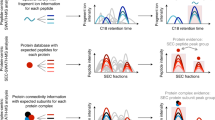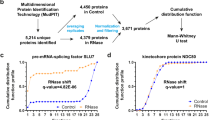Abstract
Analysis of RNA–protein complexes is central to understanding the molecular circuitry governing cellular processes. In recent years, several proteome-wide studies have been dedicated to the identification of RNA-binding proteins. Here, we describe in detail R-DeeP, an approach built on RNA dependence, defined as the ability of a protein to engage in protein complexes only in the presence of RNA, involving direct or indirect interaction with RNA. This approach provides—for the first time, to our knowledge—quantitative information on the fraction of a protein associated with RNA–protein complexes. R-DeeP is independent of any potentially biased purification procedures. It is based on cellular lysate fractionation by density gradient ultracentrifugation and subsequent analysis by proteome-wide mass spectrometry (MS) or individual western blotting. The comparison of lysates with and without previous RNase treatment enables the identification of differences in the apparent molecular weight and, hence, the size of the complexes. In combination with information from databases of protein–protein complexes, R-DeeP facilitates the computational reconstruction of protein complexes from proteins migrating in the same fraction. In addition, we developed a pipeline for the statistical analysis of the MS dataset to automatically identify RNA-dependent proteins (proteins whose interactome depends on RNA). With this protocol, the individual analysis of proteins of interest by western blotting can be completed within 1–2 weeks. For proteome-wide studies, additional time is needed for the integration of the proteomic and statistical analyses. In the future, R-DeeP can be extended to other fractionation techniques, such as chromatography.
This is a preview of subscription content, access via your institution
Access options
Access Nature and 54 other Nature Portfolio journals
Get Nature+, our best-value online-access subscription
$29.99 / 30 days
cancel any time
Subscribe to this journal
Receive 12 print issues and online access
$259.00 per year
only $21.58 per issue
Buy this article
- Purchase on Springer Link
- Instant access to full article PDF
Prices may be subject to local taxes which are calculated during checkout







Similar content being viewed by others
Data availability
A test dataset (Mass_Spec_RawData_Sample.csv), a result summary file (MS_Analysis_Shifts.csv) and two examples of graphics (HNRPU_HUMAN_FIT.pdf and HNRPU_HUMAN_FIT.pdf) are available in the Supplementary Data.
Code availability
An analysis software pipeline is provided as MS_Statistical_Analysis.R in the Supplementary Data, along with an instruction file (README.txt). The whole analysis package, including the examples, can be directly downloaded from the documentation section of our database at http://R-DeeP.dkfz.de. The software is distributed as open-source software under a 3-clause BSD license. The code in this protocol has been peer-reviewed. The analysis of the whole HeLa cell line dataset is available online as a user-friendly database at http://R-DeeP.dkfz.de.
References
Kishore, S., Luber, S. & Zavolan, M. Deciphering the role of RNA-binding proteins in the post-transcriptional control of gene expression. Brief. Funct. Genomics 9, 391–404 (2010).
Cook, K. B., Kazan, H., Zuberi, K., Morris, Q. & Hughes, T. R. RBPDB: a database of RNA-binding specificities. Nucleic Acids Res. 39, D301–308 (2011).
Gerstberger, S., Hafner, M. & Tuschl, T. A census of human RNA-binding proteins. Nat. Rev. Genet. 15, 829–845 (2014).
Ray, D. et al. A compendium of RNA-binding motifs for decoding gene regulation. Nature 499, 172–177 (2013).
Baltz, A. G. et al. The mRNA-bound proteome and its global occupancy profile on protein-coding transcripts. Mol. Cell 46, 674–690 (2012).
Castello, A. et al. Insights into RNA biology from an atlas of mammalian mRNA-binding proteins. Cell 149, 1393–1406 (2012).
Kwon, S. C. et al. The RNA-binding protein repertoire of embryonic stem cells. Nat. Struct. Mol. Biol 20, 1122–1130 (2013).
Beckmann, B. M. et al. The RNA-binding proteomes from yeast to man harbour conserved enigmRBPs. Nat. Commun. 6, 10127 (2015).
Perez-Perri, J. I. et al. Discovery of RNA-binding proteins and characterization of their dynamic responses by enhanced RNA interactome capture. Nat. Commun. 9, 4408 (2018).
Conrad, T. et al. Serial interactome capture of the human cell nucleus. Nat. Commun. 7, 11212 (2016).
He, C. et al. High-resolution mapping of RNA-binding regions in the nuclear proteome of embryonic stem cells. Mol. Cell 64, 416–430 (2016).
Bao, X. et al. Capturing the interactome of newly transcribed RNA. Nat. Methods 15, 213–220 (2018).
Huang, R., Han, M., Meng, L. & Chen, X. Capture and identification of RNA-binding proteins by using click chemistry-assisted RNA-interactome capture (CARIC) strategy. J Vis Exp, https://doi.org/10.3791/58580 (2018).
Castello, A. et al. Comprehensive identification of RNA-binding domains in human cells. Mol. Cell 63, 696–710 (2016).
Mullari, M., Lyon, D., Jensen, L. J. & Nielsen, M. L. Specifying RNA-binding regions in proteins by peptide cross-linking and affinity purification. J. Proteome Res. 16, 2762–2772 (2017).
Trendel, J. et al. The human RNA-binding proteome and its dynamics during translational arrest. Cell 176, 391–403 e319 (2019).
Queiroz, R. M. L. et al. Comprehensive identification of RNA-protein interactions in any organism using orthogonal organic phase separation (OOPS). Nat. Biotechnol. 37, 169–178 (2019).
Urdaneta, E. C. et al. Purification of cross-linked RNA-protein complexes by phenol-toluol extraction. Nat. Commun. 10, 990 (2019).
Chomczynski, P. & Sacchi, N. Single-step method of RNA isolation by acid guanidinium thiocyanate-phenol-chloroform extraction. Anal. Biochem. 162, 156–159 (1987).
Brannan, K. W. et al. SONAR discovers RNA-binding proteins from analysis of large-scale protein–protein interactomes. Mol. Cell 64, 282–293 (2016).
Treiber, T. et al. A compendium of RNA-binding proteins that regulate microRNA biogenesis. Mol. Cell 66, 270–284 e213 (2017).
Sundararaman, B. et al. Resources for the comprehensive discovery of functional RNA Eeements. Mol. Cell 61, 903–913 (2016).
Hendrickson, D. G., Kelley, D. R., Tenen, D., Bernstein, B. & Rinn, J. L. Widespread RNA binding by chromatin-associated proteins. Genome Biol. 17, 28 (2016).
Caudron-Herger, M. et al. R-DeeP: proteome-wide and quantitative identification of RNA-dependent proteins by density gradient ultracentrifugation. Mol. Cell 75, 184–199 e10 (2019).
Szklarczyk, D. et al. STRING v10: protein-protein interaction networks, integrated over the tree of life. Nucleic Acids Res. 43, D447–D452 (2015).
Ruepp, A. et al. CORUM: the comprehensive resource of mammalian protein complexes—2009. Nucleic Acids Re.s 38, D497–D501 (2010).
Kirkwood, K. J., Ahmad, Y., Larance, M. & Lamond, A. I. Characterization of native protein complexes and protein isoform variation using size-fractionation-based quantitative proteomics. Mol. Cell Proteomics 12, 3851–3873 (2013).
Hock, J. et al. Proteomic and functional analysis of Argonaute-containing mRNA-protein complexes in human cells. EMBO Rep. 8, 1052–1060 (2007).
Smirnov, A. et al. Grad-seq guides the discovery of ProQ as a major small RNA-binding protein. Proc. Natl Acad. Sci. USA 113, 11591–11596 (2016).
Fernandez-Martinez, J., LaCava, J. & Rout, M. P. Density gradient ultracentrifugation to isolate endogenous protein complexes after affinity capture. Cold Spring Harb. Protoc. 2016, https://doi.org/10.1101/pdb.prot087957 (2016).
Behal, R. H. & Cole, D. G. Analysis of interactions between intraflagellar transport proteins. Methods Enzymol. 524, 171–194 (2013).
Kalthoff, C., Alves, J., Urbanke, C., Knorr, R. & Ungewickell, E. J. Unusual structural organization of the endocytic proteins AP180 and epsin 1. J. Biol. Chem. 277, 8209–8216 (2002).
Gagnon, K. T., Li, L., Janowski, B. A. & Corey, D. R. Analysis of nuclear RNA interference in human cells by subcellular fractionation and Argonaute loading. Nat. Protoc. 9, 2045–2060 (2014).
Hafner, M. et al. Transcriptome-wide identification of RNA-binding protein and microRNA target sites by PAR-CLIP. Cell 141, 129–141 (2010).
Sysoev, V. O. et al. Global changes of the RNA-bound proteome during the maternal-to-zygotic transition in Drosophila. Nat. Commun. 7, 12128 (2016).
Rinn, J. L. & Chang, H. Y. Genome regulation by long noncoding RNAs. Annu. Rev. Biochem. 81, 145–166 (2012).
Castello, A. et al. System-wide identification of RNA-binding proteins by interactome capture. Nat. Protoc. 8, 491–500 (2013).
Castello, A. et al. Identification of RNA-binding domains of RNA-binding proteins in cultured cells on a system-wide scale with RBDmap. Nat. Protoc. 12, 2447–2464 (2017).
Pillai, R. S. et al. Inhibition of translational initiation by Let-7 microRNA in human cells. Science 309, 1573–1576 (2005).
Wu, Y., Li, Q. & Chen, X. Z. Detecting protein–protein interactions by far western blotting. Nat. Protoc. 2, 3278–3284 (2007).
Tyanova, S., Temu, T. & Cox, J. The MaxQuant computational platform for mass spectrometry–based shotgun proteomics. Nat. Protoc. 11, 2301–2319 (2016).
Cox, J. et al. Andromeda: a peptide search engine integrated into the MaxQuant environment. J. Proteome Res. 10, 1794–1805 (2011).
Ashburner, M. et al. Gene ontology: tool for the unification of biology. The Gene Ontology Consortium. Nat. Genet. 25, 25–29 (2000).
Acknowledgements
This research was partially supported by a DKFZ NCT3.0 Integrative Project in Cancer Research grant (NCT3.0_2015.54 DysregPT to S.D.) and grants R35GM119455 and P20GM113132 from the National Institute of General Medicine (to A.N.K.). We thank the Loayza-Puch group (DKFZ, Heidelberg) and the Cathomen group (Medical Center, Freiburg) for allowing us to use their ultracentrifuges. We thank all members of the Diederichs and Kettenbach labs for their comments and suggestions on the method.
Author information
Authors and Affiliations
Contributions
S.D. and M.C.-H. conceived and developed the R-DeeP procedure, including the statistical analysis pipeline. All authors wrote the manuscript.
Corresponding authors
Ethics declarations
Competing interests
S.D. is co-owner of siTOOLs Biotech GmbH, Martinsried, Germany, which has no relation to this study or competing interests. The other authors declare no competing interests.
Additional information
Peer review information Nature Protocols thanks Alfredo Castello, Markus Hafner and the other, anonymous, reviewer(s) for their contribution to the peer review of this work.
Publisher’s note Springer Nature remains neutral with regard to jurisdictional claims in published maps and institutional affiliations.
Related links
Key reference using this protocol
Caudron-Herger, M. et al., Mol. Cell 75, 184–199.e10 (2019): https://doi.org/10.1016/j.molcel.2019.04.018
Integrated supplementary information
Supplementary Figure 1 Analysis of samples treated with individual RNases.
Western blot analysis for hnRNP U (RNA-dependent protein) in fractions of control and individual RNase-treated samples as indicated (RNase A, RNase I, RNase T1, RNase III or RNase H) in HeLa cells (N = 1). For all western blots, the fractions were loaded onto two membranes (1: fractions 1 to 13 and 2: fractions 14 to 24).
Supplementary Figure 2 Effect of various centrifugation times.
Western blot analysis for hnRNP U (RNA-dependent protein) in fractions 12 to 25 of control (untreated) samples loaded onto 5% to 50% sucrose density gradients and centrifuged for 18 h, 6 h or 2 h, as indicated. One representative replicate out of two replicates is shown.
Supplementary Figure 3 Western blot analysis of individual proteins.
Western blot analysis for Nucleolin (NCL, RNA-dependent protein) in 25 fractions of representative control and RNase-treated samples in HeLa cells. b, Same as in a for MCM7 (RNA-independent protein). c, same as in a for hnRNP U (RNA-dependent protein) but in A549 cells. d, same as in a for ASNS (RNA-independent protein) but in A549 cells. For all western blots, fractions 1 to 25 were loaded onto two membranes (1: fractions 1 to 13 and 2: fractions 14 to 25).
Supplementary Figure 4 Schematic overview of western blot quantification.
The single steps for western blot quantification with the software ImageJ are shown (Steps 43–49). The generated intensity table can be copied and pasted to a program (e.g. Microsoft Excel) for further data processing and production of a graphical output. The intensities of each experiment are normalized as follows: \(normalized\,protein\,amount = \frac{{intensity\left( x \right)}}{{\mathop {\sum }\nolimits_{y = 1}^{25} intensity\left( y \right)}} \times 100\) for the fraction x.
Supplementary information
Supplementary Information
Supplementary Figs. 1–4.
Supplementary Table 1
Checklist for reproducible TCA precipitation
Supplementary Video 1
Gradient preparation.
Supplementary Video 2
Gradient fractionation.
Rights and permissions
About this article
Cite this article
Caudron-Herger, M., Wassmer, E., Nasa, I. et al. Identification, quantification and bioinformatic analysis of RNA-dependent proteins by RNase treatment and density gradient ultracentrifugation using R-DeeP. Nat Protoc 15, 1338–1370 (2020). https://doi.org/10.1038/s41596-019-0261-4
Received:
Accepted:
Published:
Issue Date:
DOI: https://doi.org/10.1038/s41596-019-0261-4
This article is cited by
Comments
By submitting a comment you agree to abide by our Terms and Community Guidelines. If you find something abusive or that does not comply with our terms or guidelines please flag it as inappropriate.



